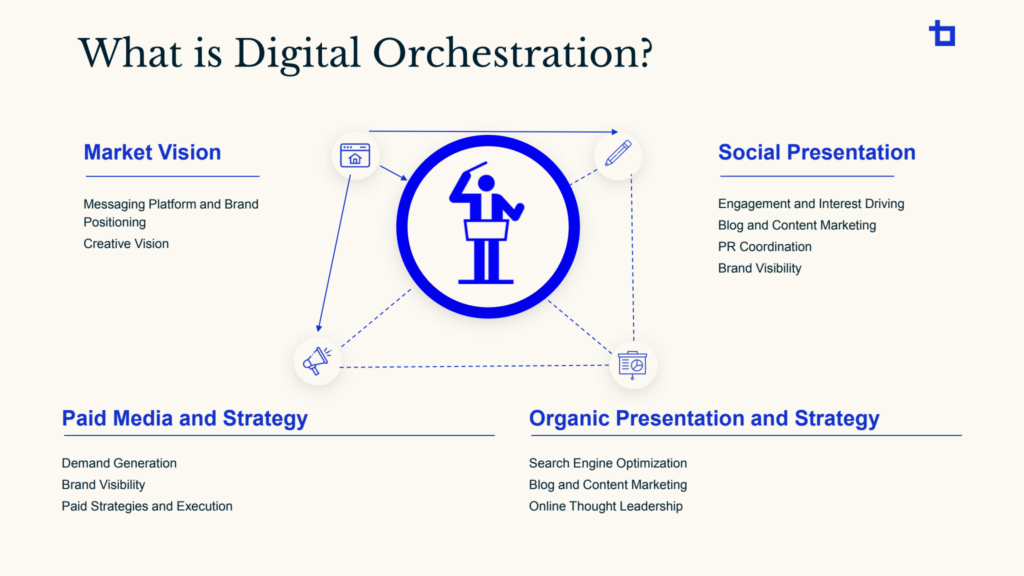Embark on a captivating journey through the transformative tale of a marketing leader who navigated the challenges of the pandemic, reshaping the events industry with resilience, innovation, and strategic decision-making. Join us on Digital Doorways as we explore the remarkable story of triumph in an era of eventlessness, uncovering the secrets behind adapting and thriving in the world of digital experiences.
🎧 Listen to the Digital Doorways Podcast here
Go-to-market campaigns are incredibly beneficial to reaching your marketing goals — whether that’s generating mass brand awareness, driving new traffic to your site, or producing quality conversions. No matter what your campaign goal is, one thing will always be true: tracking is a must.
Campaigns are only beneficial when you can understand and measure the data. How are users engaging with your ads? What is their user journey like when they reach your site? Where and why are they bouncing off the site? These questions – and dozens more – will help you make informed, data-driven decisions to fine-tune your campaign’s performance.
Successfully setting up UTM (Urchin Tracking Module) parameters will allow you to easily track and measure your campaigns, and will help you draw conclusions as to what’s working and what needs improvement.
What are UTM parameters and why are they important?
UTM, or Urchin Tracking Module, codes are small snippets of text that are added to the end of URLs so that you can easily track your marketing campaigns. While UTMs are most commonly used for paid media ads, you can leverage UTMs to successfully track organic social posts, earned media article placements, and more. If users can click on a URL that drives to your site, you should always try to add UTM codes to that URL.
There are five (5) total UTM parameters that you can add to your URLs:
- utm_source: Identify the advertiser, site, publication, etc. that is sending traffic to your property, for example: google, newsletter4, billboard.
- utm_medium: The advertising or marketing medium, for example: cpc, banner, email newsletter.
- utm_campaign: The individual campaign name, slogan, promo code, etc. for a product.
- utm_term: Identity paid search keywords. If you’re manually tagging paid keyword campaigns, you should also use utm_term to specify the keyword.
- utm_content: Used to differentiate similar content, or links within the same ad. For example, if you have two call-to-action links within the same email message, you can use utm_content and set different values for each so you can tell which version is more effective.
At a minimum, we recommend adding the source and medium parameters; however, the more parameters you add, the more granular the tracking becomes and the more detailed your data/reporting will be. All of this information will seamlessly integrate into your GA4 dashboard. UTM parameters are also picked up through other software platforms, such as HubSpot, Salesforce, Marketo, and more.
Why UTMs are important
As noted, campaigns can only be beneficial if you are able to gain insights from the data you collect. While ad platforms can provide KPIs such as clicks, impressions, CTRs, and conversions, the most important data related to your campaigns will come through once a user visits your site.
UTM parameters allow you to analyze users’ website experience at a campaign, term, or even content level. This level of granularity will allow you to easily A/B test against different ad copy, call to action, ad imagery, landing page hero zones, form types, and more. Measure the success of these tests by reviewing engagement metrics (avg. time on site, engagement rates, pages/session, form submissions).
UTM parameters can also be tied to CRM (customer relationship management) platforms, which we strongly recommend if applicable. In addition to understanding the number of conversions that are tied to each of your unique parameters, you can also start to measure the quality of conversions.
Let’s say you have two unique utm_term parameters – Blue and Red. In GA4, we can see that Blue has driven 100 conversions while Red has only driven 50 conversions. If we were to stop measuring there, we would assume Blue is the clear winner. However, when reviewing these UTM terms in Salesforce, we see that Blue has only produced 3 qualified sales conversions, while Red has driven 10 qualified conversions. This information tells an entirely different story; while Red has driven fewer overall conversions, the qualified conversion rate is 560% higher than Blue.
Bottom line: the more granular you can get with tracking – with UTM parameters, and with syncing UTM parameters to all marketing platforms – the more successful your campaigns will be.
UTM Templates
If you are new to implementing UTM parameters, it can feel like a daunting process. Luckily, there are free tools online that allow you to easily build out custom URLs.
UTM builder is a great, free, tool that you can use to generate UTM codes. This is a great place to start to gain familiarity with the UTM process.
However, as noted, the more granular you can get with UTM parameters, the better. The UTM builder site is great for generating a handful of custom URLs, but that manual process will eat up a lot of your time – and we marketers don’t have time to waste! For a more automated process, we would recommend creating a custom UTM spreadsheet – see examples here. With these spreadsheets, you can automate your URL-building process, producing 100s of custom URLs in minutes.
NOTE: Before generating any URLs with UTM parameters, be sure to connect with your web development team to establish any UTM rules. For example, some platforms only allow lowercase UTM parameters to be passed through. Make sure to connect with the appropriate contacts on your team to ensure all UTMs will be successfully mapped to the marketing platform(s) you plan to use.
If you’re planning to run a marketing campaign in the near or distant future, be sure to establish UTM parameters!
Successfully track, measure, and update your campaigns based on the data you’re able to analyze through your UTM parameters. Start making informed, data-driven decisions based on these unique insights. Create a custom UTM parameter template so that you can streamline and automate the custom URL process.
Whether you’re new to the paid media scene, or a seasoned veteran ready to optimize campaign performance, Bluetext has the experience and expertise to support your business from start to finish. Contact us to learn more about our campaign creation & management services.
In today’s business climate, companies face fierce competition to capture the attention of their target audience. To succeed, it is crucial to leverage multiple marketing channels effectively. Four key components of a comprehensive marketing strategy are SEO, Paid Media, Social Media, and Content Development. Here at Bluetext, the integration of these marketing strategies is known as digital orchestration. In this blog post, we will explore each of these services and discuss the benefits of hiring a marketing agency like Bluetext to manage them in an integrated fashion, maximizing your business’s online presence and driving success.
Search Engine Optimization (SEO)
SEO is the practice of optimizing a website to improve its visibility and organic search rankings on search engine results pages. A marketing agency can help businesses develop a comprehensive SEO strategy, including keyword research, on-page optimization, technical SEO, link building, and content optimization. By achieving higher search engine rankings, companies can attract more targeted organic traffic, increase brand visibility, and establish authority in their industry.
Paid Media
Paid media involves running targeted advertising campaigns across various digital platforms, such as search engines, social media, and display networks. Bluetext can expertly handle the planning, execution, and optimization of paid media campaigns, ensuring maximum return on investment. By leveraging data-driven insights, audience targeting, and ad optimization techniques, businesses can reach their target audience, increase brand exposure, and drive conversions effectively.
Organic Social Media
Social media has become an integral part of modern marketing strategies. A marketing agency can manage a business’s social media presence across platforms like Facebook, Instagram, Twitter, LinkedIn, and more. They create and curate engaging content, interact with the audience, monitor brand mentions, and run targeted social media advertising campaigns. Social media management helps companies build a loyal following, increase brand awareness, drive website traffic, and foster meaningful customer relationships.
Content Development
Content development involves creating high-quality and engaging content that resonates with the target audience. A marketing agency like Bluetext can develop a content strategy aligned with the company’s goals, target market, and SEO strategy. This includes creating blog posts, articles, infographics, videos, and other forms of content. Compelling content not only attracts and engages the audience but also supports SEO efforts, drives organic traffic, and establishes the business as a thought leader in its industry.
Digital Orchestration: Benefits of Integrating Marketing Services
By hiring a marketing agency like Bluetext to orchestrate these services in an integrated way, companies can enjoy several key benefits:
- Holistic Marketing Approach: An integrated approach ensures that all marketing efforts are aligned and work together synergistically, reinforcing each other’s impact and maximizing results.
- Consistent Brand Messaging: An agency can develop a cohesive brand voice and maintain consistent messaging across all marketing channels, enhancing brand recognition and maximizing customer trust.
- Efficient Resource Allocation: Outsourcing marketing services to an agency allows businesses to focus on their core competencies while leveraging the expertise of professionals dedicated to driving marketing success.
- Enhanced Data Analysis: A marketing agency can provide valuable insights and analytics across all marketing channels, enabling businesses to make data-driven decisions and optimize their strategies for better performance and ROI.
- Cost-Effectiveness: Outsourcing marketing services to an agency can be more cost-effective than hiring an in-house team, as agencies have the expertise, tools, and resources necessary to deliver results efficiently.
An integrated marketing approach that combines SEO, Paid Media, Social Media, and Content Development can significantly boost a company’s online presence and drive success. By hiring a marketing agency that specializes in these services, businesses can benefit from a cohesive strategy, consistent brand messaging, data-driven insights, and cost-effective resource allocation. Looking for an agency to lead the orchestration of your digital marketing channels? Contact Bluetext today.
Welcome to Digital Doorways, the podcast that takes you on an immersive exploration of the ever-changing landscape of branding, marketing, and digital revolutions. I’m your host, Jason Siegel, founder of Bluetext, a top creative digital marketing agency headquartered in Washington DC. Today, we embark on a captivating journey as we delve into the remarkable mental shift experienced by marketing professionals. We are honored to have Nick Panayi, Chief Marketing Officer at Inovalon, a leading healthcare analytics and technology company, as our special guest.
Nick’s expertise spans two very special CMO journeys that have helped shape his career. The first journey revolves around the formation of a new brand through the merger of one of the world’s largest IT services firms with Hewlett-Packard, an iconic technology company. Nick played a pivotal role in this transformation, which brought together immense industry knowledge and technological prowess.
The second journey focuses on Nick’s transition from a leading human-based IT services company to a world-leading digital employee-based IT services company. This shift marks a pivotal moment in the industry, as traditional methods intertwine with the ever-expanding digital landscape. Nick’s experience navigating this dynamic terrain provides valuable insights into the challenges and opportunities presented by the digital era.
Join us as we warmly welcome Nick to this episode of Digital Doorways, where we unravel the secrets behind these captivating journeys and explore the fascinating intersection of marketing, technology, and the evolving landscape of human-based versus digital employee-based services and artificial intelligence.
Welcome to Digital Doorways, the podcast that takes you on an exhilarating exploration of the ever-changing landscape of branding, marketing, and digital revolutions. Published by Bluetext Founder Jason Siegel. For this episode, we are thrilled to bring you the exceptional insights of Rob Pinkerton, a true marketing luminary with a remarkable career trajectory.
Following the successful acquisition of his company, HelloWallet, by Morningstar, Rob’s expertise was recognized, leading to his appointment as their Chief Marketing Officer. His remarkable eight-year tenure at Morningstar, four times longer than the industry average, stands as a testament to his transformative impact on marketing strategies.
Have you ever pitched a reporter with a story or announcement you thought would definitely catch their attention only to be ghosted? It’s happened to all of us at some point in our careers, in no small part because, frankly, journalists are drowning in pitches.
In Cision’s 2022 survey, more than half of the 3800 journalists responded that they received over 50 pitches a week through email, phone or social media, and about 24% of them received up to 100 per week.
As PR professionals, we are responsible for building brand reputation and promoting businesses in a positive light. To do so, we need to be armed with data and facts to create campaigns that will evoke the right response and reach the intended audience in an authentic way.
So, how can PR pros break through the noise? How do we grab the attention of reporters and other audiences? The key is infusing company stories and narratives with data.
Why use data-driven storytelling?
Data-driven storytelling helps construct and communicate a compelling story that drives action and can be the difference between a successful campaign and one that gets lost in the busy news cycle.
By accurately presenting data associated with clients, you can improve narrative-building and storytelling capabilities, connecting clients to the public in a meaningful way.
For example, personal finance, business and local consumer interest reporters are annually inundated with tax-related pitches leading up to April’s big filing day. To catch their attention, data is critical. We worked with one of our clients to build a campaign anchored by data that showed tax scam robocalls increased in volume ahead of Tax Filing Day, while also uncovering localized data narratives specific to scams circulating in different markets.
Having this reliable data to back up the story around consumer scams and awareness for Tax Day helped drive media opportunities for the client, which can help increase engagement with the public, generate interest and spark further conversation.
How to use data to tell your clients’ stories
While creativity and relationships are key components of a great public relations strategy, facts are what seal the deal. Here are four ways you can use data and spread a narrative.
- Use newsworthy statistics. When pitching a story, data drives the narrative forward. Incorporating attention-grabbing statistics helps give your narrative a solid foundation of evidence while making the content more persuasive and impactful. With newsworthy statistics, you can hope to get your client’s story more attention and media coverage.
- Frame data in the right context. Data is important, but what matters more is how you frame that data. Before sharing any statistics, make sure that you’re choosing the right facts and figures and putting them in a context that is relevant to your client’s story so that readers can instantly understand the implications of the facts you’re presenting. It’s also imperative that your spokespeople are well-equipped with the necessary data and have the right talking points to frame the story correctly.
- Follow up with visualizations. To bring your story to life and make it stand out, it’s a good idea to back up your data with visualizations such as graphs and charts. Doing this can help paint a vivid picture that reinforces the narrative you’re trying to pitch while making the story more engaging and easier to digest.
- Understand data trends. Data also provides powerful insights into the conversations happening around a brand or company, allowing you to see what phrases or keywords people are using to talk about it, how often to post about it, and which channels are being used for engagement. With this data, you can see what topics or trends are resonating with target audiences and adjust the strategy accordingly.
Data can be a PR pro’s best friend when used effectively. By framing data in the right context and following up with visualizations, reporters are likely to be engaged by your clients’ stories and more likely to cover that story.
A single well-crafted story backed with facts, statistics and data can go a long way in making your stories powerful, authoritative, and attractive to both reporters and the public.
Learn more about Bluetext’s data-centric PR approach, or contact us to hear about our full life-cycle marketing services.
What’s the latest in AI tools? After months of new software making significant waves in the creative industry, Adobe has finally launched its own AI image generator. While still in the beta stages of development, the debut of Adobe’s Firefly & Generative AI marks a significant enhancement to the creative suite already in use by millions. So rather than paying for and downloading additional products, such as DALL-E or MidJourney, designers now have the tools of AI at their fingertips within Photoshop, Illustrator & Premiere applications.
Much like other AI tools on the market, Adobe’s product allows users to type in a prompt and have an image created in return. But one critical difference is Adobe is one of the few companies willing to discuss what data its models are trained on, and eliminates the controversial copyright concerns. According to Adobe, every asset being fed into its models is either out of copyright, licensed for training, or in the Adobe Stock library, which the company has the right to use. This gives Adobe’s product an additional leg up in the AI race as there is no risk of copyright or trademark infringement which has been creating much controversy amongst the design community. VP of Generative AI & Sensei, Alexandru Costin, claims, “We can generate high-quality content and not random brands’ and others’ IP because our model has never seen that brand content or trademark.”
So is it worth the hype? Bluetext’s designers took a tour of the beta program to test its capabilities and pressure test some potential applications. Our main takeaways? Well, like any AI tool on the market, there are obvious advantages, but still notable weaknesses proving AI technology is indeed a work in progress and never a full replacement for human abilities.
Let’s explore some of Bluetext’s experiments with Generative AI.
One of the most impressive feats of Adobe’s generative fill is the ability to enhance imagery with additional subjects. So what had previously taken creative hours to clone, align, fill, and blend imagery. But now, AI tools can accelerate that process by enabling a designer to select an area, type in a prompt, and receive three results to select from. For example, we took this photo of simple but scenic mountains.

We asked Adobe AI for a series of additions, including more mountains, a cliffside mansion, and even a goat.



Overall we were extremely impressed with the tool’s ability to blend new creative into the previous scene, as the new mountains and mansions were almost a seamless match to the focus, lighting, and textures of the original scene. While not all of the generated options were a great fit for our requested prompt, the majority of outputs fit the requested prompt pretty spot-on.
So with that experiment’s success, we decided to pressure test some more difficult subject matter. One of the core obstacles to AI-generated imagery tools is the inability to produce realistic and believable human subjects. AI tools often have what is called the “uncanny valley” effect. This phenomenon refers to the natural emotional response of eerie or unsettling feelings that people experience in response to not-quite-human. The majority of people have an aversion to the imagery that is meant to appear human but with some caveat of disproportion or unrealism. This phenomenon occurs often with computer-generated imagery that technically appears human, or humanoid, but has a “can’t put my finger on it” inconsistency that appears robotic or unnatural. After the prompt in Adobe AI to generative fill in “a man/family eating ice cream” into the amusement park scene below it confirmed our hesitancies.






The generated responses yielded a mix of graphic styles, resulting in distorted human photography and clip-art-esque illustrations. Facial features and phalanges were expectedly distorted, as these are the features that are most difficult to create hyper-realistic depictions.
While adding people to the scene created challenges, we found removing people was very realistic. The removal of foreground elements is a significant strength in Adobe’s tool, as it cuts out significant time to remove elements from a scene and recreate backgrounds. Our result generated a perfect match to the park’s backgrounds in a matter of seconds, with impressive accuracy and attention to detail that would have taken any designer hours to complete.
Another powerful potential application of generative fill is the resizing of imagery for specific proportions. For example, say you found a great image you want to use as a website hero zone background. The only problem is this selected image is portrait orientation, making it incredibly difficult to adapt to wider landscape or even square formats. Adobe’s generative fill allows the user to select specific areas, and generate that exact texture, background, or graphic elements across a new canvas size. Especially for abstract and texture-based imagery, this seamlessly recreates the design to fill negative space. The previously limited portrait image is now croppable and has more flexibility to be scaled to various formats for websites, display ads, social platforms, and more.


Overall, our stance on AI-generated design tools remains the same. There are undeniable advantages to accelerating tedious tasks and supporting ideation phases, however, still require a significant amount of human attention and editing. AI tools are not, and likely will not, ever be a full replacement for human talent and still face severe limitations in creating certain subjects like human faces or fingers. AI tools are much more adept at scenery, abstract subjects & textures and when used correctly can be a powerful addition to your creative team.
Interested in AI tools? check out our Midjourney case study and how generative AI can enhance ideation.
If you’re starting off your press releases and pitches with boilerplate language, you might as well crumple them up, toss them in a garbage can, and set them on fire.
Alright, that may be slightly overdramatic. But it got you to keep reading the next few sentences, didn’t it? Attention is an increasingly precious resource in this age of constant stimulation, so grabbing hold of it and keeping it is paramount for any PR professional trying to get a message out into the world.
Standing Out in the Crowd
When a pitch is one of the hundreds in a reporter’s inbox, or a press release is one of the thousands published daily on the news wires, you can’t take for granted that anyone will read your content and understand the full scope of your announcement. A reporter may only see the first words in an email preview before deciding whether to open or delete an incoming pitch, so if the subject line hasn’t already grabbed them, your opening is your final chance to make the case for your message’s relevance.
Some contexts and audiences require an established professional tone, necessitating a more formal approach. But where there is an opportunity to add energy to your message without spilling over into the bombastic, introducing dynamic language can make all the difference. In other words, don’t “improve” your opening lines— supercharge, enhance, or revamp them.
From Standard to Stronger
The start of a message doesn’t have to be extreme or court outrage to be compelling — it only has to be unique and inspire curiosity to learn more. Methods may vary depending on the industry you’re working in or the types of audiences you’re speaking to, but there are a few core techniques that can reliably improve the start of your messaging. The following examples of standard introductions show how they can be strengthened by using these techniques:
Pitch Email – Make it Personal, Tell a Story
Standard opening: Hi Tom, I saw you have been covering trends in technology and wanted to share some information on new advancements in AI. An expert I work with has spoken on the anticipated opportunities and challenges at several conferences and can capably speak to the current moment…
There’s nothing wrong with this opening, but it is likely identical to dozens of other pitching messages Tom regularly receives. If the subject line isn’t compelling enough on its own, the body of the message is unlikely to improve the chances of your message being read. By making the introduction more personal, demonstrating familiarity with the reporter’s work specifically, and telling a story, we can strengthen this opening:
Stronger opening: Tom, I couldn’t agree more that “we’re on the precipice of the greatest global transformation since the internet,” as you said in your recent piece. That’s exactly how the AI expert I work with describes what’s coming. At a recent conference, he told me about his predictions for the next five years over a lukewarm hotel coffee and…
Press Release – Share a Surprising Fact, Use Dynamic Language
Standard Opening: City, State (Date) — A new survey released by IT firm Example Company shows that business leaders already use AI in their daily work. The survey, which polled 2,000 corporate workers, found that 68% of respondents have been utilizing the latest AI innovations.
This introduction is accurate, and you don’t want to stray too far from the core facts of the announcement. Still, by frontloading the interesting fact, using bolder language, and providing relevant context, the basic facts of this release can take on a more dynamic form.
Stronger Opening: City, State (Date) — Over two-thirds of business leaders are already using AI every day, according to a landmark survey of IT professionals conducted by Example Company. This finding, among several other insights in the full report, paints a picture not of an industry on the brink of transformation but an evolution actively underway.
Article – Ask a Provocative (But Fair) Question, Demonstrate Value
Standard Opening: Some workers express trepidation about using AI tools in their jobs, citing concerns about their role being deprecated by new technology. But these workers may not appreciate the ways in which AI can improve their experience at work.
This introduction clearly sets the stage for what the article will entail. But unless a reader is already interested in the topic and independently curious to learn more, they are unlikely to dive into this article. To improve this introduction, we can begin with a compelling question and clearly state how the reader stands to benefit from the message at hand:
Stronger Opening: Do you love every part of your job? Chances are, there are some tasks you begrudgingly complete and others you actually look forward to. Thankfully, the routine, mundane tasks that can make the workday feel longer are precisely the types of tasks AI tools excel at handling. Less time doing data entry or collating spreadsheets translates to more of your time dedicated to meaningful or creative tasks.
Going Bold Without Going Overboard
There’s a fine line to walk between an opening that is compelling and intriguing and an opening that is inflammatory or misleading. Bold openings require substantive and useful information in the body of the message in order to deliver their intrigue and avoid seeming like a bait-and-switch. If you begin with an unusual question, be sure to provide an answer or interesting points in support of different perspectives. Likewise, if you begin with a strange fact, ensure that it relates to the ultimate focus of your message. Starting an article with “Did you know frogs use their eyes to swallow?” may make readers continue reading the piece, but unless your story is related to frogs, it will seem like a cheap non-sequitur by the end of the article.
Of course, there is room for nuance, detailed explanation, and essential facts in PR messaging. But readers will only give that kind of material the attention they require if they are already invested in the story you are telling. Earning that attention with a strong and compelling introduction allows you to slow down and take time on the most critical details.
You would probably not be reading this conclusion if this blog post had started: “Writing an engaging introduction in press materials is a very important part of PR messaging, as it establishes a tone that encourages further reading.” But with a strong start, the piece becomes more engaging and ultimately reaches a broader — and more engaged — audience.
Interested in taking your press strategy to the next level? Contact Bluetext to learn about our PR services.
Shortened attention spans. Optimized online search efficiency. A click-and-go world. Writers go up against all to capture reader’s attention. Everyone is trying to find something as fast as possible when we search online, so we expect efficiency in everything, including all of the copy that we read. According to user experience experts, a user will leave a webpage within 10-20 seconds.
What does this mean for you as a copywriter or journalist? You need concise, attention-grabbing content at the top of every page of your website, every blog and every article or press release. You need the eyebrow raise: an introduction that both grabs attention in a unique way and preempts reader’s need or desire. A clear, well-outlined value proposition can capture and hold user attention and help you accomplish your goals.
Introduction Essentials
Though there are different strategies for getting the eyebrow raise, a good introduction will consist of three concise parts: the point of differentiation or reader problem, the solution and the user action. You must not only capture reader’s attention but also give them what they are looking for and provide an action to take.
Raising Those Eyebrows
There are many different ways to get to the eyebrow raise moment: that moment when your user stops scanning and pays real attention to your content. We’ll walk through a few of these and provide examples that you can emulate.
Define the problem, evangelize the solution
A user scrolling a website or reading an article is almost always looking for a solution to a problem. If you can articulate that problem (maybe even for ones they haven’t recognized yet), then you can set your business or your content up as the solution. Attention and connection go hand in hand here. If your audience can read a headline and instantly relate to the problem or circumstance, you’ve got them hooked to find the solution.
For example: You’re a cybersecurity company with continuous 24x7x365 data protection. You need a way to reach customers.
An introduction that defines the problem: “Cybersecurity is a continuous battle, but you don’t have the resources for always-on, 24x7x365 reinforcements.”
And evangelizes the solution: “Luckily, we do. We provide you with the 24x7x365 data protection that you need to rest easy and focus your resources on winning new business.”
Interest-grabbing macro statement or question
Another approach to the eyebrow raise is a question or bold, overarching statement. A question can inform a reader of a need or desire they have that they might not have been considering. A bold statement can stop a scanner in their tracks. Take our cybersecurity example from earlier:
An attention-grabbing question: “Are you certain of your data defenses? If you don’t have 24x7x365 data security, you could be leaving your most important business asset exposed.” The question sows some doubt and primes the reader for a solution to this problem.
A bold statement: “Make data breaches disappear” A bold and interest-grabbing statement makes the reader want to learn more.
A series of questions or statements
We started this post with this strategy. The repetition of parallel structures (a series of questions or short statements) can capture the eye and turn a scanner into a reader.
A series of questions: “Are you certain of your data protection? Want to ensure it’s secure? Not sure where to start?” This parallel structure guides the natural progression of a reader’s thoughts toward a solution that you’ll provide.
A series of statements: “Perimeter defense. In-transit data protection. Storage encryption. All of these on their own are not enough to protect your data.” This structure not only captures the eye but also defines the “solutions” that the reader may already have and urges them to discover why they’re not good enough.
A personal or emotional appeal that sets the stage
Finally, a personal appeal or a story can help set the stage for further discovery or user action. This could take the form of a change in tone or a direct address to the reader.
Personal appeal: “We’ve all been there. Your current data protection tool isn’t cutting it and you don’t know what to do.” This strategy not only provides a problem that we will provide the solution for, but the direct address also captures attention.
Concoct the Solution
After all of these strategies, outline the solution or outcome for your readers. Provide the payout that your readers, clients or customers are looking for. Maybe that’s a list of the best ways to craft an interesting introduction or maybe it’s 24x7x365 data protection that they can afford. However, this solution should not only include what you offer, but what the practical outcome will be for them. Finishing this article will help you get better at capturing and holding your audience. Data protection will enable you to spend your resources on growing your business.
And, Action!
An attention-grabbing introduction should include an action to take. What do your readers need to do? Read on, learn more, and talk to our team – all actions you can suggest to move your readers from discovery to action.
No matter what you’re writing for, you need to capture and keep the reader’s interest. The eyebrow raise intro (in all its many potential forms) is crucial to doing this and to encourage your readers to read on, learn more and take the next step with your business.
Contact Bluetext if you’re curious about how our content marketing expertise could escalate your business.
It’s May and you know what that means, graduation season is upon us. Amongst the throws of graduation caps and kick-off to summer celebrations, higher education gets more attention than ever. And while prestige and name value still play a significant role, numerous other factors have recently come into play for prospective students. Between funding, affordability, student mental health, and diversity initiatives schools are taking drastic steps to stand out and modernize. From the degrees offered and course formats, to who they recruit and more importantly how they recruit. One tactic many higher education institutions have latched onto is branding, especially to portray a bolder more forward-looking image to prospective students, professors, and donors.
In this post, we’ll break down the recent trend toward bolder branding within higher education, an industry that had traditionally foregone flashy aesthetics and in-your-face campaigns. In such a serious industry with a heavy emphasis on facts and figures, many institutions hesitate to emphasize the human element of education. However, to make a memorable impact during the admissions process, many schools are taking courageous steps to graduate toward bold branding.
The University of Virginia Darden School of Business’s “Put Your Why To Work” campaign is one noteworthy example timed with the opening of their Rosslyn outpost. To grab the attention of prospective MBA students Darden chose a people-first perspective that highlighted the ‘why’ before the ‘how’. Connecting the passion and purpose behind the degrees gave the audience a chance to relate and be inspired for the next steps toward their own career. Between clever taglines and artistic photo treatments, real student stories and motivations behind their MBA drove this campaign. The orange duotone treatment of Grounds and student portraits stood out from competitors and instilled the iconic UVA branding with a more grown-up twist.
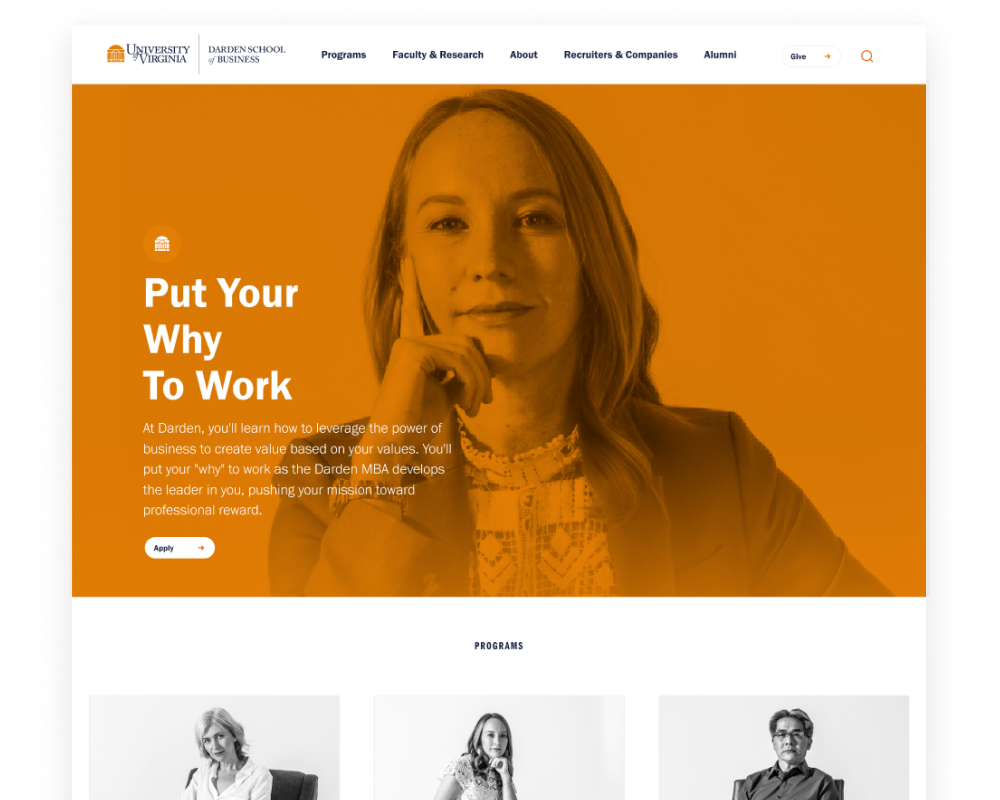
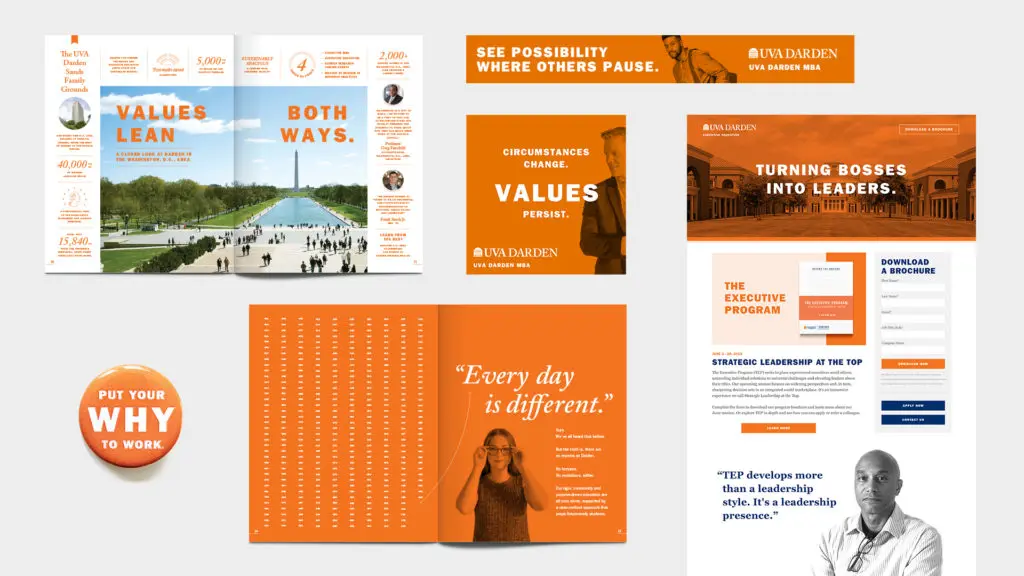
Purdue University recently unveiled a brand evolution with its “The Next Giant Leap” campaign. Intended to harmonize the school’s athletic identity with innovative programs into a “One Purdue” shared ethos. Emphasizing the importance of both giant leaps and small steps forward, the campaign and new brand story aim to harmonize the collective efforts of each individual student towards a shared vision. Refining their color palette, logo, and brand materials, Purdue put an emphasis on consistency and unity in their new brand identity.
Watch the brand story: https://youtu.be/uHm63Gpxf_A

Another example, Bluetext client GMAC, took on bold updates to improve the usability and engagement of their MBA microsite CallingAllOptimists.com. After taking on a bold new brand identity full of vibrant colors and eye-catching animations, they needed modern functionality to match the aesthetic. Bluetext took on the challenge to design and develop a personalized quiz that seamlessly guided the user to customized messaging and content based on their answers, while simultaneously gathering actionable user insights. With over 400K site visitors and 50K+ interactions, the pool of audience data was vastly increased.
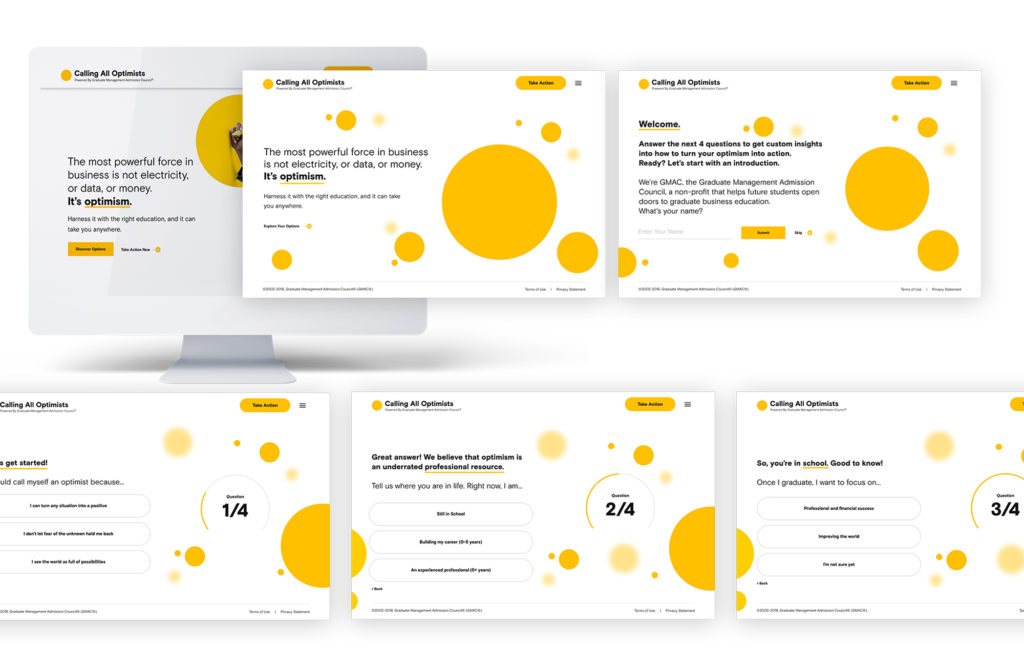
The Bluetext team designed a media campaign to deliver personalized and culturally-agnostic content through paid social and programmatic media, new video assets, and radio advertising. Sensational visuals, engaging messaging, and efficient audience segmentation – delivered the right inspiration to the right person at the right time. Not only did this redesign improve the campaign’s functionality and awareness – it created a holistic, and optimistic, brand ecosystem.
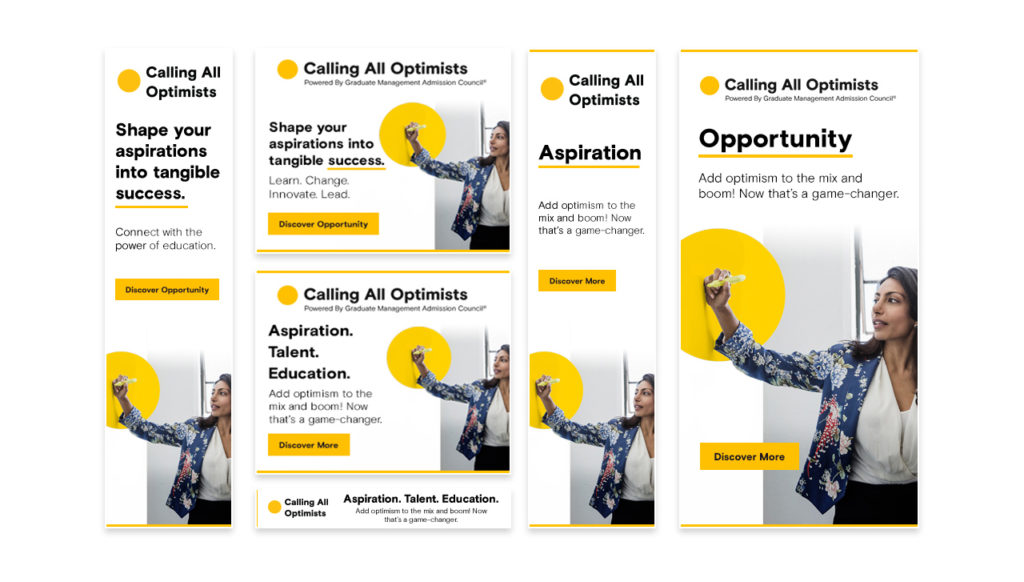
So what have we learned from these examples? Don’t worry this is not the final branding exam, but these examples are A+ examples of how traditionally serious institutions can take a more creative approach to their marketing efforts to stand out from the sea of schools vying for students’ attention. Incorporating modern UX functionality, human perspectives, and bold visuals can elevate a company of any industry from one of many to a top-of-mind brand name. Interested in taking your brand to the next level? Contact Bluetext to learn about our services and proven approach to success.
